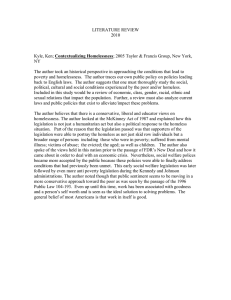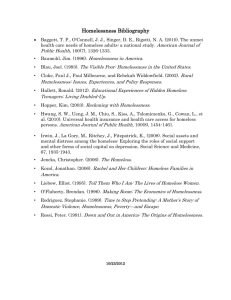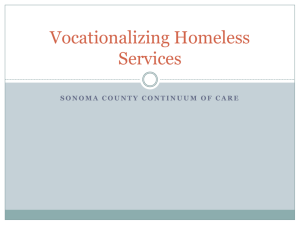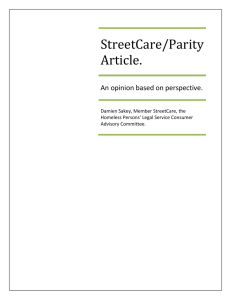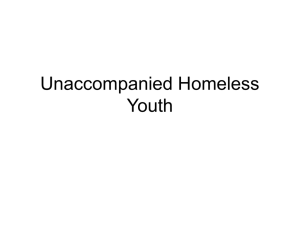Social exclusion of homeless people in Germany
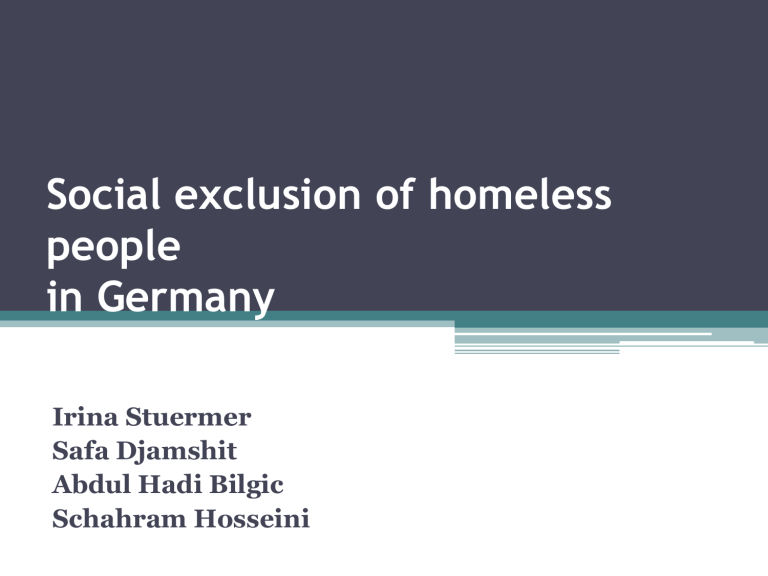
Social exclusion of homeless people in Germany
Irina Stuermer
Safa Djamshit
Abdul Hadi Bilgic
Schahram Hosseini
Definition of homelessness
• Homelessness is defined as a state in which humans have no fixed abode, and live in public places, outdoors, in shelters or hospital-stay.
"Make disk" "push" or or "on his plate," the colloquial term for example in parks, on benches, under bridges, in doorways, construction sites, railway stations for spending the night. The term "shelter" means accommodation or housing.
Causes of homelessness
• Common causes of homelessness are:
* Rent arrears and evictions
* Divorce from your spouse or partner's death
* Unemployment and illness or addiction such as alcohol or drug dependency
* Lack of rehabilitation after prison
* Mental disorders.
Homelessness with children
• Common causes of homelessness among children and adolescents are:
* Material poverty and homelessness of the entire family
* Escape from violence or abuse at home
* Escape from constant conflicts with other family members
* Escape from shelters
* Lack of money in the family.
Number of homeless people
Consequences of homelessness
• *Lack of medical care, inadequate medical examinations, no or substandard drugs;
* Lack of hygiene, uncleanliness, lack of washing facilities, dirty and stinking clothes;
* Exposure to the weather conditions such as heat, cold, rain and snow, lack of physical recovery; death by freezing in winter
* Inadequate diet, consumption of spoiled food, lack of vitamins and minerals, emaciation;
* disease, particularly through miscarriages and malnutrition, immune deficiency
* Violent and sexual assaults such as rape, theft, robbery, and sometimes even physical
•
•
Violence, homicides too ;
* Changes in the character of the "street life" by addiction to drugs and discrimination by the rest of the population,
• * "Acquisitive crime" in order to get money
Government role in preventing the exclusion of homeless people:
• Every community in Germany has to accommodate the homeless. Guaranteed in our Constitution is all the basic right to physical integrity and it is to protect the role and duty of the municipalities within their jurisdiction of this fundamental right,
• must Cities and towns sufficient number of emergency shelters ready. Due to the increased number of homeless people , they should check if the measures taken are sufficient. This also affects the quality of Emergency accommodation places.
Institutions and their actions
• Evangelische Obdachlosenhilfe [www.evangelischeobdachlosenhilfe.de
• Katholische Arbeitsgemeinschaft Wohnungslosenhilfe
[www.kagw.de]
• Diakonisches Werk der EKD [www.diakonie.de]
• Deutscher Caritas Verband [www.caritas.de ]
• Die Heilsarmee [http://www.heilsarmee.de ]
• Die Bahnhofsmissionen [http://www.bahnhofsmission.de
• Die Tafeln [http://www.tafel.de ]
• Rotes Kreuz [http://www.drk.de ]
Katholische Arbeitsgemeinschaft
Wohnungslosenhilfe (KAGW):
• Is committed to the needs of homeless people and supports their independent advocacy;
• Represents the concerns and interests of its members and member organizations at the federal level;
• Promote the exchange and cooperation between the bodies and institutions on a regional level;
• Cooperating with all the homeless make associations and organizations;
• Fosters cooperation and networking with other disciplines with the goal of full and barrier free demandoriented assistance;
Diakonisches Werk der EKD:
• Diakonie stands for the social work of the churches other than the Roman Catholic Church.
• Activities in Germany include:
▫ Elder care
▫ Support for the unemployed
▫ Youth welfare
▫ Support of people with disabilities
▫ Family welfare
Characteristic of Kurhessen-Waldeck
• The origins of diaconal work in Kurhessen-Waldeck date back to the poor foundation of the Middle Ages.
• Today, the Social Service Agency in the Electorate of
Hesse-Waldeck eV around 210 charities, foundations and non-profit limited liability companies, and 26 church districts, municipal associations and numerous parishes in the Church.
• The association represents the interests of currently around 210 members (associations, foundations, nonprofit limited liability companies, Protestant church groups and communities, Protestant nurseries, nationwide church-purpose associations). In its more than 600 institutions currently operate approximately
12,500 full-time staff and countless volunteers.
• The work of diakonia is in-patient facilities financed primarily through service charges. These are of the pension, health care insurance or social assistance, and the media - but also paid by the person affected.
• You can find this in the facilities of both Diakonia in the form of counseling centers and day visits as well as in various forms of housing. The diverse variety of charitable organizations based on the individual concerns of the Council, and seeking help. Here you will find hospitality, personal attention, compassion, support and solidarity.
